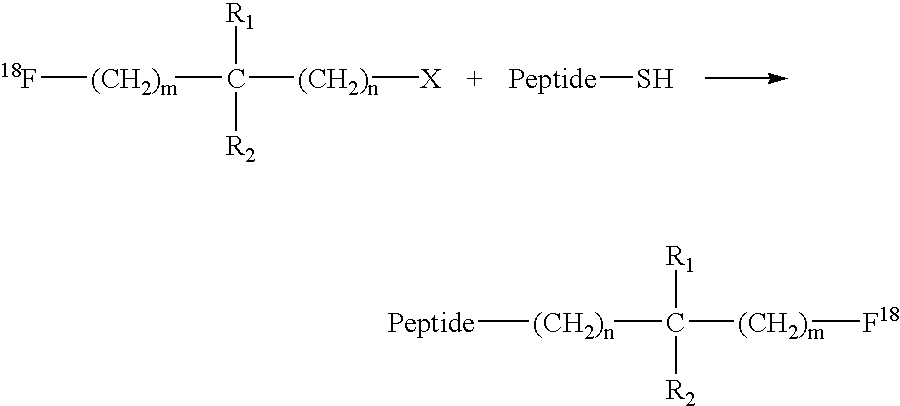Fluorination of proteins and peptides for F-18 positron emission tomography
a technology of positron emission tomography and fluorination of proteins, which is applied in the field of radiolabeling proteins and peptides with fluorine18 (f18), can solve the problems of complex chemistry, tedious methods, and requiring the efforts of specialized professional chemists
- Summary
- Abstract
- Description
- Claims
- Application Information
AI Technical Summary
Benefits of technology
Problems solved by technology
Method used
Image
Examples
examples
Fluorodiiodoacetic acid (18F—CI2COOH)
[0046]100 mCi of F-18 fluoride (obtained from bombardment of O-18-enriched water) in dry tetrahydrofuran containing Kryptofix 2.2.2 (4,7,13,16,21,24-hexaoxa-1,10-diazabicyclo[8.8.8]hexacosane) and a slurry of potassium carbonate is treated with triiodoacetic acid. After a 30 minute reaction at room temperature, the desired labelling reagent, 18F—CI2COOH, is obtained and purified by reverse-phase column chromatography. This labelling reagent is then used to label a variety of thiol-containing targeting vectors, or is shipped to clinical sites for the same usage.
F-18-Labeled Fab′-SH Fragment
[0047]A 1 mg vial of lyophilized Fab′-SH-NP4 (an anti-carcinoembryonic antigen antibody fragment) is reconstituted with 1 mL of a solution of 18F—CI2COOH in 0.1 M sodium acetate buffer at pH 6. The reaction is allowed to proceed for 30 minutes at room temperature.
[0048]An aliquot of the mixture is removed for analysis by HPLC using a size-exclusion sizing column...
PUM
 Login to View More
Login to View More Abstract
Description
Claims
Application Information
 Login to View More
Login to View More - R&D
- Intellectual Property
- Life Sciences
- Materials
- Tech Scout
- Unparalleled Data Quality
- Higher Quality Content
- 60% Fewer Hallucinations
Browse by: Latest US Patents, China's latest patents, Technical Efficacy Thesaurus, Application Domain, Technology Topic, Popular Technical Reports.
© 2025 PatSnap. All rights reserved.Legal|Privacy policy|Modern Slavery Act Transparency Statement|Sitemap|About US| Contact US: help@patsnap.com


